Alex Watts's Blog, page 10
May 15, 2012
Phsar Prahok: One Of The Smelliest Places In The World

I was in an area where no-one speaks any English,
and I’d got lost trying to find what I’d been told was one of the smelliest places in
the world - Cambodia’s prahok-making hub, Phsar Prahok (fish paste market), on
the banks of the Sanke river near Battambang , where hundreds of tons of
freshwater fish are bought and sold each year.
How anyone would ever know it was one of the smelliest
places in the world, I have no idea, and I’ve been to a few. But mention the
name and even Cambodians hold their nose. I kept cycling up and down a mud track
lined with stalls, and stopped to ask people for directions. But no-one knew what
I was going on about.
The smell of rotten fish was definitely getting
stronger though. There was just a gentle breeze in the hot midday sun, but
sometimes with the wind on my face as I cycled, there was the distant whiff of Cambodia’s
infamously smelly fermented fish paste .
I kept cycling, and then stopped to ask an old woman
for directions. She was selling fresh spring rolls at the side of the road. She
had five chairs outside her stall, and her cats took up two of them. I didn’t
want to push them off. They looked vicious. The sort of cats used to keep snakes
away.
I thought about dark, hooded encounters with monocled
cobras hissing like garage tyre inflators. One of the cats yawned at me and
stretched out its claws. It licked its lips, and we both looked round in the
same direction. The wind had definitely changed. The smell of rotten fish was coming
from somewhere behind those trees to the north-east.
I asked the woman again and she kept shaking her
head when I said Phsar Prahok. Then she asked if I could speak French. She
started to babble and slowly a few words came to me, and before I knew it she
was shouting Phsar Prahok exactly the way I’d said it to her, and I’d gone
through a number of possibilities.
She slapped me on the chest, as if to say ‘why
didn’t you say so all along’, and then pointed to where the ginger cat was
drooling. A mile later, the stench of fermented fish was breathtaking. It
smelled worse than the crocodile farm I’d been forced to spend two days in for
a story about whooping tourists hurling live chickens and ducks into crocodile pens.
It’s so strong if you get some on your hands while dipping
chunks of barbecued veal and raw vegetables in prahok sauce, you soon know
about it. Even bleach doesn’t get rid of the smell. Or as someone once said: “To describe prahok as
pungent is being too charitable. It smells like it should be buried with corn
seed.”
There was a huge fish processing plant hidden behind
iron gates and then further on, where the boats were moored on the Sanke, a
long line of huts filled with people covered in fish guts. Men were offloading fish they’d netted from the river,
and the locals were sorting them into plastic barrels and crates before the
real process of prahok fermentation would begin, exactly the way their ancient ancestors
had done to preserve fish and guarantee a year-round supply of protein.
The fish are cleaned and then salted and mashed
underfoot in barrels before being left to rot in the sun for a day - which
helps kick off the fermentation process. More salt is added. Then they are weighted
and left in huge barrels for months, depending on the desired taste or price,
with prices rising in the rainy season when the paste becomes scarce.
River fish are put in barrels and salted...

The fish ferment and become a grey, cheese-like paste...
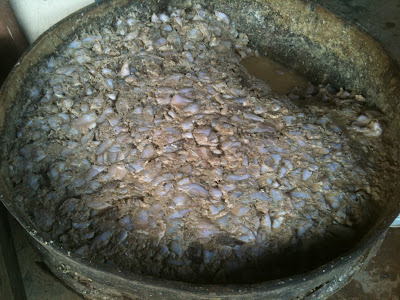
Prahok chopped and ready to cook...
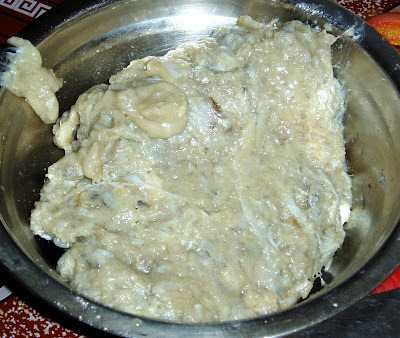
The taste and smell varies largely from batch to
batch, depending on the type of fish used, how carefully they’ve been prepped,
and the time, skill and methods used to ferment them. The cheapest stuff is filled with bones, fins, and
scales like the bag of prahok I’d bought from a street stall on the coast last
month. It looked like it had been made from crab bait, and had a disconcerting
ripeness.
In some of the other huts they were smoking and curing fish . Racks of fish no bigger than minnows were being slowly grilled
over charcoal coals until deep bronze and rigid. Some of the larger fish were
being turned into maam, a more expensive version of prahok. It’s salted for 24
hours, then stacked in a jar with salted rice and galangal, and stored for less
time (usually a month) until it becomes sour.
It’s these fermented fish products that define traditional
Khmer food and differentiate it from the strong culinary influences of China,
Vietnam, Thailand, and much further back, India and Sri Lanka.
Many countries use fermented pastes and sauces, of
course, to add the savoury, meaty ‘fifth taste’ of umami to food. China and
Japan have soy sauce and miso made from fermented soy beans, wheat flour,
water, and salt. Vietnam and Thailand have fish sauce, drained from salted and
fermented anchovies, prawns or squid. Malaysia has its blocks of fish paste, or
blacan, and there are many other varieties around the world.
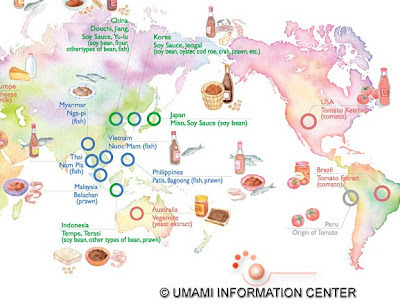
But none of them have the cheesy punch of prahok. Most
people agree it tastes of blue cheese. But it’s more the harshness and
saltiness of Danish blue rather than the creamier, more refined flavour of say
Roquefort or stilton. And always there on the palate and in the nose is the
smack of rotten fish, as though you’ve been cutting skata with the cheese
knife.
For that reason, you don’t see it on restaurant
menus much, especially in places where tourists go. Sadly, many Khmers talk
about how it’s now looked down on by Cambodia’s emerging middle class as a
reminder of the bad old days. They say it’s the smell of poverty - a
remembrance of their tough, previous lives working on the farm.
It’s certainly true of Cambodia’s highly
aspirational pop videos, which always seem to feature affluent, pale-skinned
Khmer couples posing around in shiny SUVs that would keep a whole village in
food for a year. You never see them munching prahok at a street stall. It’s
always pizza, burgers or fried chicken in soulless, chain-style restaurants.
It breaks my heart more than the appalling car crash
at the end, which is how most Khmer music videos seem to end, with a girl
crying hysterically, holding the lifeless body of her boyfriend in her arms,
and screaming “WHY!” at the sky. Which is not the best viewing when you’re
being forced to watch it on a bus clattering away on tyres with less grip than
a pickled egg.
After an hour, I could take no more and cycled
across the bridge to the old woman’s stall. The cats were still there, but this
time there was a seat free. The ginger cat sniffed the air again and looked at
me. The smell had suddenly got a lot stronger.
:: MORE: Prahok: My Secret Addiction To Cambodia's Fermented Fish 'Cheese'
:: MORE: A Umami-Packed Dish That Makes Marmite Taste Like Boiled Cabbage
:: BOOK UPDATE:
I want to apologise for the very poor delivery times of the paperback version of my new food book Down And Out In Padstow And London. For reasons that are beyond me, Amazon have had problems distributing recent batches. It’s something to do with the wrong metadata being input, whatever that means. But Completely Novel who print my book have promised they are trying to sort it out.
I don’t know how long it will continue, but I’ve been told that books ordered through Amazon will arrive soon, and they will obviously not take your money until they do post the book to your address. To help remedy this, an eBay page has been set up to sell my book. So if you want the book in the next few days, then cancel your order at Amazon and buy the book HERE ... For the eBook version click HERE ...
Published on May 15, 2012 03:18
May 8, 2012
A Message In A Bottle To Rick Stein
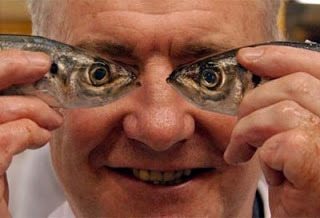
You
meet some very strange people in Cambodia . It’s a place full of misfits and
loners. Expats escaping from something, or looking for something, and nearly
always reinventing themselves in the process. In fact, I don’t think I’ve ever
come across such a high concentration of alcoholics, junkies, perverts, arseholes,
and compulsive liars.
For
instance, I met a guy the other day who said he was the executive chef of a
group of luxury hotels. He walked into the bar, introduced himself, and then held
court on his barstool telling us how difficult it was drumming the basics of
hygiene into his Cambodian cooks. We got chatting and I told him about my dismal
failure retraining as a chef and the book, Down And Out In Padstow And London ,
I’d written about my experiences.
I
told him how the cheffing door had been opened when Rick Stein agreed to let me
do a week in his Seafood Restaurant in Cornwall. The executive chef suddenly
butted in.
“He’s
one of my best friends!” he beamed. “He even sent me a long email when Chalky
died. He loved that dog. He was devastated.”
He
told me they’d done their chef training together in France, and hinted at the
drunken nights they’d had. I listened on, but was thinking of something else. I’d
been wanting to send the celebrity chef an email thanking him again for the
opportunity he gave me, and how if he hadn’t, my book would probably never have
been written.
But
I’d lost Stein’s email address and knew if I sent a message through his PR
people it would probably never get to him. I’d have more chance of sending him
a message in a bottle from one of Cambodia’s soon-to-be-developed Robinson Crusoe
islands.
So
when the executive chef eventually paused to take a swig of beer, I asked if he’d
mind passing my thank you letter on to the TV chef. He handed me a smart
business card with his email on it.
“Not
a problem,” he said, “Oh, we had some times together!”
Then
he stopped suddenly and looked slightly angry and bitter.
“Do
you know the difference between him and me? Do you know how he got to where he
is and I didn’t?” He didn’t wait for an answer: “Luck!”
A couple
of days later I wrote a thank you letter to Stein and emailed it to the executive
chef. I didn’t hear anything back. Not even anything to say he’d got it. Then a
couple of weeks passed and my suspicions were finally confirmed when I was back
in the same Irish bar talking to the owner Ronan.
He
told me the executive chef had been in a few days before and tried some of his
Irish stew - a dish tongue-in-cheekily described in his bar adverts as “the
best Irish stew in Cambodia”.
We’d
been chatting about the best way to cook it because the price of lamb out here
- $47 for a small frozen leg imported from New Zealand - makes it impossible to
make. At least at a price the cheapskate losers in Sihanoukville are prepared
to shell out for. Goat would have been the next best option, but we couldn’t
get hold of that, and when I jokingly suggested dog meat Ronan looked appalled.
“My
dog would smell it! He’d never come near me again!” he whimpered.
So
I told him to use beef instead, but to throw in a few anchovies to give it a richer
flavour. He made the stew with the usual chunks of carrots, potatoes and
onions, and then showed me his secret of mashing up a few of the spuds and
putting them in a thin layer in the bottom of each bowl, and pouring the stew
on top. It was a nice touch and kept the broth high in the bowl while allowing
people to thicken the thin liquor to their liking.
He told
me the executive chef had raved about it in the pub. Tom began laughing, his
arched eyebrows wiggling away.
“’Oh,
he said, that’s a lovely bit of lamb! Where did you get the neck fillet from?’
Fucking lamb! And he’s an executive chef! People were listening, so I just
played on. What the fuck could I do? I said: ‘Oh, I get it from this butcher...’
‘I love lamb!’ he says. ‘It’s my favourite fucking meat.’ What the fuck! You
couldn’t make that up now could you!”
No
wonder the bloke hadn’t replied to my email. It probably wasn’t even his
business card. The real executive chef was probably thinking who the hell is
this idiot. I had to get the letter to Stein myself. The next day, I searched
through my contacts list again for the TV cook’s email, and then decided to
send a message to his press department, asking them if they would mind passing
my letter on to Stein in between dunking digestives.
Surprisingly,
I got an email from his PA the next day. She said she had forwarded the letter to
Stein. And a week or so later, an email arrived from the celebrity chef,
thanking me for my letter and saying: “I've heard a lot about the book and am
ordering it.”
I
can’t tell you how pleased I was. I’ve always liked the man. I know I rant
about celebrity chefs and say they should all be napalmed, but like Fergus
Henderson or the late Keith Floyd , who sparked the pandemic of TV cooks, he’s
so different from the morons that plague our screens, newspapers, magazines,
billboards, government campaigns, and stock cube adverts. He’s got a brain for
a start.
Can
you imagine Gordon Ramsay , James Martin , Hugh Fearnley-Whittingstall or Gary Rhodes even talking to you unless there was something in it for them, let alone
arranging for a stranger and complete novice to do a week in one of their restaurants?
And the lesser known TV chefs trying to squeeze their way up the rat cage walls
are even worse.
I
wonder what Stein will think of my book? I think he comes across pretty well,
even if I do mention him in my tirade about celebrity chefs never actually
being in the kitchen. I know he’s touchy about the name Padstein too, and there’s
plenty on that.
But
I’m far harsher on other TV chefs like Heston Blumenthal , who I only saw once
in the three weeks I worked at the Fat Duck, and that was just a glimpse of him
on the stairs as he took a break from filming in the lab. He didn’t even come down
to the prep room to shake our hands and thank us for working for free in his
restaurant. I wonder if that nutter in the bar knows him as well?
Book
Update:
I
want to apologise for the very poor delivery times of the paperback version of my
book Down And Out In Padstow And London. For reasons that are beyond me, Amazon
have had problems distributing recent batches. It’s something to do with the
wrong metadata being input, whatever that means. But Completely Novel who print
my book have promised they are trying to sort it out.
I
don’t know how long it will continue, but I’ve been told that books ordered
through Amazon will arrive soon, and they will obviously not take your money
until they do post the book to your address. To help remedy this, an eBay page
has been set up to sell my book. So if you want the book in the next few days, then cancel
your order at Amazon and buy the book HERE ...
Published on May 08, 2012 13:38
May 6, 2012
Book Review: Down and Out in Padstow and London by Alex Watts

A newspaper review of my book in the Maidenhead Advertiser - original article HERE ...
By Nicola Hine
If
you can't stand the heat, get out of the kitchen – or so the saying goes.
But
how many people can actually say they've leapt out of the frying pan and into
the fire in pursuit of the career they've always dreamed of?
Lennie
Nash did when he ditched the relative comfort of the world of newspaper
journalism in a bid to become a professional chef.
And
while the results were pretty disastrous, the risk has brought success in the
form of Down and Out in Padstow and London – the written account of his
experiences.
An
honest and enjoyable read, it begins when Lennie – better known as
Burnham-based journalist Alex Watts – engineers a chat with TV chef Rick Stein
and secures himself work experience in one of the restaurateur's Cornwall
kitchens.
He's
long dreamed of owning a seaside fish restaurant of his own and makes the
decision to 'kick off the slippers and feel alive again'.
The
need takes him from one restaurant to another, ranging from the most basic of
establishments to the Michelin-starred kitchens of cooking royalty.
It
brings about a failed audition for Masterchef, which sees Lennie make sushi in
a bid to impress Greg 'the egg' Wallace and John 'the toad' Torode.
It
also introduces a whole host of questionable characters ranging from a racist
homophobe to a stroppy 19-year-old who locks him in a walk-in chiller.
Lennie's
laugh-out-loud anecdotes include dressing in bin liners to pluck pheasants with
a helpmate who does puppet shows with the dead birds' heads, and turning up to
a placement at Heston's most famous restaurant armed with two knives in a Tesco
bag.
In
fact, arguably the highlight of the book is his time at The Fat Duck in Bray,
which he describes as 'a three-star Michelin restaurant famous for concoctions
like snail porridge, bacon and egg ice cream and a food poisoning outbreak that
struck down 500 diners'.
From
peeling grapefruits to prising open oysters – both equally painful but for
different reasons – Lennie's jobs at 'the gastronomic equivalent of the centre
of the universe' are a brilliant insight into Blumenthal's lair, although the
real secrets remain closely guarded.
The
whole book is a real eye-opener into the differences between the TV image and
the reality of the kitchen, particularly where celebrity chefs are concerned.
It's
sharp, easy to read and almost impossible to put down, whether you're genuinely
tempted to follow in Lennie's footsteps or you'd rather stick to watching
Masterchef on the sofa.
Personally
I think I'll stick to my desk for now – but I look forward to a sequel.
:: Down And Out In Padstow And London is available as a paperback and eBook on Amazon CLICK HERE
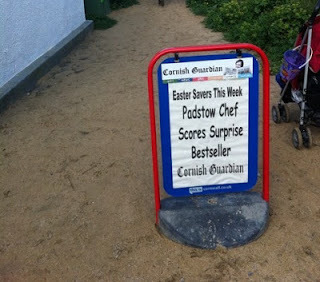
Other Newspaper Articles...
Padstow Chef Scores Surprise Bestseller
Down And Out In Padstow And London Becomes Cooking Bestseller
Failed Chef's Book Becomes Kitchen Bestseller
Twitter Reviews:
"Cracking
read...It's great - seek it out. Raw, honest, funny, great stories..." @eatlikeagirl
"Just
finished reading Alex Watts’ terrific book - must read for anyone interested in
food/cooking/restaurants." @jteramsden
"Bought
your book and am hugely enjoying. Funny, engaging, interesting, lively."
- @oliverthring
"Great
book, Alex - a one-sitting read! Love the Chelsea-Barca scene! " @MarkLewis32
"A
rattling good read." - @chrispople
"Sensational account of a chef’s life, couldn't put it down. Get it from
Amazon now!" @Fishermansarms
"It's
a fab read. The Fat Duck chapters are class." - @Mcmoop
"Really
enjoyed it. Such refreshing food writing. Looking forward to your sequel..."
@Jen_foodmag
"So
this morning I bought Alex Watts’ book and now at the end off the day the book
is done. Really enjoyed it - so easy and funny to read." @darrencoslett
"Bloody
loving it..." @babaduck71
"Deserves
to be bestseller - great book." @Blostins
"You
will not be able to put it down - great read." @MTomkinsonChef
"Great,
great stuff." @VictoriaHaschka
"Loving
@alexwatts book, Down & Out In Padstow & London. A must read for
wannabe chefs!" @londoneating
"A
good read." @matkiwi
"A
must read!" @brockhallfarm
"Currently
motoring through your book. Great read - quite an eye-opener. Hopefully not an
old wound-opener for you!" @drdickdixon
"Really
enjoying Alex Watts’ book Down and out in Padstow and London. Worth a read."
@Christian_Ace
"Thought
the book was great, felt exhausted just imagining the work levels (and monotony
- e.g. grapefruit!) " @applelisafood
"Just
read Down And Out In Padstow & London by @alexwatts. Good read but couldn't
take heat of being a chef." @karenmediawales
"Loved
your book. Thanks for such a fascinating read." @hubbs
"I
just finished reading your book, I very much enjoyed it. Bravo." @hungerincardiff
"Thanks
for a good read, made my commute a lot nicer. My wife who's a Masterchef fan
didn't find it as amusing as I did though!" @erik_me
"If you claim to be a foodie you MUST buy this
book." @CorkGourmetGuy
"A great read about the reality of working at The Fat Duck & other
less famed restaurants." @alanbertram
"Very funny, very close to the bone." @AmeliaHanslow
"A great read and must have book for anyone in the industry." @philwhite101
"Thoroughly enjoyed it." @rosechadderton
"Excellent!" @MissCay
"Just finished your book, and loved it! Thanks for ending on a happy note;
it needed it after all the reality ;-)" @voorschot
"Fab account of psycho chefs, plus work experience with Heston and
Stein." @Laurajanekemp
"Excellent read & loved the ‘scary duck’ tale! I look forward to the
follow up book (no pressure ;D). Great memories of first being addressed as
chef." @granthawthorne
"I'm loving your book. Very enjoyable. Some great one-liners. "His
legs wobbled like a crab on stilts" had me chuckling." @griptonfactor
"Highly recommended. A great book about changing careers for his love of
cooking." @Whatsinmymouth
"Downloaded the book last Sunday and finished it the same day! Great
read." @MTomkinsonChef
"Very funny." @SkyRuth
"Any of you who have flirted with chefdom, go and immediately download
this book from Amazon - Down and Out in Padstow and London. Great read." @el_duder
"Truly brilliant." @kcassowary
"Just rattled through Down And Out in Padstow and London by Alex Watts in
no time at all, what a great book." @leejamesburns
"It's brilliant, a fine piece of work. If you've ever wanted to peer into
a professional kitchen I can't recommend it highly enough." @acidadam
"Fantastic read - the English Kitchen Confidential!" @cabbagemechanic
"A great eBook to buy about serving your time (literally!) as a trainee
chef." @OkBayBach
"Great read." @rankamateur
"Don't start reading it if you have things to do:)" @NorthernSnippet
"Great book...couldn't put it down, read it non-stop on a train and
finished it in one day." @chunkymunki
"Jolly good read, feel free to do one more. " @esbens
Published on May 06, 2012 10:17
Is Phnom Penh Really Being Overrun By Filipino Blackjack Gangs?

An article I wrote for Khmer 440...
I
take everything I read in the Phnom Penh Post with a large bucket of salt,
especially after noticing it couldn’t even get the date right on the front page
a couple of months back. I’ve had fun spotting appalling errors like “insert
byline here” in big bold print where a reporter’s name should be – perhaps
indicating that even the subs don’t read the paper.
But
it’s not just the subs. Far from it. A story this week must have left readers
with the impression that if you take even a few steps down the riverside area,
you’ll be pestered by armies of gangsters trying to scalp you of thousands of
dollars in rigged blackjack games.
It
appears you can’t walk anywhere in the capital’s tourist spots without some
kindly member of a Filipino crime syndicate complimenting you on your
sunglasses or choice of ice cream, and before you know it you’re hypnotised into
a tuk tuk.
Generally,
the fraudster will make up a story about how his (insert relative) is heading
to your country and could you give some advice/assurance to (insert relative)
while enjoying a lovely meal at their home. Then you’ll be hoodwinked into a
game of cards upstairs, frogmarched to a bank to pay off your losses, and end
up walking home without your shirt.
Continue reading ...
:: My new book 'Down And Out In Padstow And London' about my disastrous attempt to train as a chef, including stints at Heston Blumenthal's Fat Duck, Rick Stein's and other restaurants, is available as a paperback and eBook on Amazon CLICK HERE
Published on May 06, 2012 09:31
Damming The Mekong: Cambodia Facing A Thai-Made ‘Catastrophe’

An article I wrote for Khmer 440...
Weighing
up short-term economic gains against long-term environmental costs is always a
thorny issue in geopolitics. But when the profits are reaped in one country and
the ecological costs are suffered in another, then it’s all the more
problematic.
There
are few better examples than the controversial hydroelectric dams planned for
the Mekong River – particularly the Xayaburi Dam in northern Laos, which
campaigners say could devastate fish stocks in Cambodia and Vietnam by blocking
migration routes, and may lead to the extinction of critical species like the
giant Mekong catfish and Irrawaddy dolphin.
In
a worrying development, it appears Thailand’s CH Karnchang is ploughing ahead
with construction of the $3.5bn site despite regional agreements that no work
should take place until more environmental research is done into the likely
impact on the 60 million people living in the Lower Mekong area.
On
Tuesday, the development company’s chief executive Plew Trivisvavet informed
the Thai Stock Exchange that its subsidiary Karnchang (Lao) had signed a
contract with the Xayaburi Power Company (conveniently, another subsidiary of
CH Karnchang) – and construction work was scheduled to begin on March 15 last
month.
At
the time of writing, the Cambodian government said it was trying to get
confirmation from Laos that the dam was going ahead, and that the need for
further study agreed by the four members of the Mekong River Commission (MRC) –
Thailand, Cambodia, Laos and Vietnam – last December had been ignored.
Officials
again warned of the huge environmental costs the project is likely to bring to
Cambodia and its future generations, and stressed the need for more research to
be carried out.
Continue reading ...
:: My new book 'Down And Out In Padstow And London' about my disastrous attempt to train as a chef, including stints at Heston Blumenthal's Fat Duck, Rick Stein's and other restaurants, is available as a paperback and eBook on Amazon CLICK HERE
Published on May 06, 2012 09:22
Cambodia’s Booming – So Why Is It The ‘Least Thriving Country In The World’?
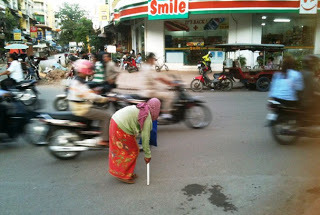
An article I wrote for Khmer 440...
I
read a column in the Bangkok Post this week, entitled Poor Cambodia Not Looking
So ‘Poor’ Anymore, which began as a thank you letter congratulating Cambodian
PM Hun Sen for his hospitality during the ASEAN summit.
The
letter took a swipe at the obvious wealth in Phnom Penh, mentioning how
everyone was now the proud owner of a Lexus, and questioning whether the
Kingdom still needed the huge amount of foreign aid it receives, when the
streets were so obviously paved in gold.
Although
the article pondered whether the word “poor” now only applies to the rural
population, and whether any of the aid money actually reaches Cambodians in
need, it’s a shame that foreign correspondents didn’t stray further than the
scrubbed streets of the capital, which had been cleared of beggars and other
unsightly features, and go in search of the truth themselves.
A
quick trip into villages far from main roads would have shown the appalling
poverty, malnutrition, stunted growth, and lack of education and healthcare. It
would have hammered home how little money has trickled down to the people it’s
supposed to help. “What’s that? There’s a new Range Rover coming out?” And
that’s just the NGOs.
John
Macgregor, from the Lom Orng Organisation, an NGO which doesn’t use SUVs or
consultants, and is helping flood victims in north-west Cambodia, gives a very
depressing picture of life in some villages. He says residents in one
rice-growing commune on the Thai border are spending nearly half of their
disposal income just on trucked-in water and medical bills.
Continue reading ...
:: My new book 'Down And Out In Padstow And London' about my disastrous attempt to train as a chef, including stints at Heston Blumenthal's Fat Duck, Rick Stein's and other restaurants, is available as a paperback and eBook on Amazon CLICK HERE
Published on May 06, 2012 09:12
May 5, 2012
The Fat Dragon: A Tale Of A Cook And A King

I’ve just published a children’s story in rhyme called The Fat Dragon, which began with an idea I had while prepping endless boxes of veg training as a chef .
The first few lines about a King and his love of lime kept spinning round my head for some reason. It was probably the tiredness and the sleep deprivation. I jotted them down that night after the pub, and in the morning had a couple more lines.
Over the months, as I moved from kitchen to kitchen, I kept a small notebook and a blunt pencil in my back pocket. And whenever an idea or new line came to me, I wrote it down. Or at least I tried to in between the orders, heat, and constant bollockings.
It took a long while, and kept going off in different directions. Then I burnt the notebook because it was all rubbish.
I kept the stuff about the King and the limes. Oh, and the cook and the greedy dragon. And then I spotted a folk tale in one of my favourite books ‘Folklore, Myths and Legends of Britain’ - a tome-like work heavy enough to press a huge terrine.
There was a story from the Midlands, or thereabouts, about a potwash, a King growing old, and a dragon who plagues the land.
I don’t know why it appealed so much, but there seemed to be a lesson in it somewhere. At least there was for me. So I padded out what I had, and wrote it up in rhyme.
Anyway, sorry for the shameless plug, but if you’ve got kids - or are a kid at heart - you might enjoy it. It’s available as an eBook on Amazon for the price of a bag of Monster Munch. CLICK HERE ...
Published on May 05, 2012 07:17
April 30, 2012
What’s Really In Your Lamb Doner Kebab?
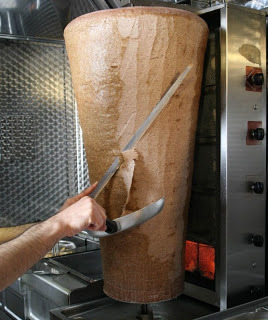
Doner kebabs may originate from a predominantly
Muslim country - but Muslims who eat them in Britain may be unwittingly eating
pork, a report has warned.
Undercover trading standards officers who carried
out investigations into 20 restaurants and take-aways found that none of the lamb
kebabs tested contained just lamb as stated - and that four of the lamb curries
didn’t contain any lamb at all.
They found that suppliers were bulking out the
Turkish dish with cheaper meats like pork, chicken, and beef in a bid to
increase profits while customers were told they were getting 100% lamb with
their pitta, salad, and chill sauce. Some even claimed to be Halal.
Of the 19 lamb curries tested at kebab shops picked
at random in Stratford upon Avon, Leamington Spa, Nuneaton and Rugby, only three
contained just lamb. Most contained a mixture of lamb padded out with pork, beef
or poultry.
Officers from Warwickshire County Council trading
standards also found that 70% of the lamb kebabs contained high levels of
artificial colouring - which can cause health problems. One kebab contained 18
times the safe level of colouring, and another was 13 times higher.
As well as revealing how kebab shops were ripping
off customers, officers said the findings would cause concern for people who
don’t eat certain meats for religious or health reasons.
Warwickshire County councillor Richard Hobbs,
portfolio holder for community safety, said: “Consumers rely on accurate food
descriptions. Some foods are not permitted to be eaten by some religions and
cultures, whilst some people may wish to avoid some foods because of allergy
concerns.
“Consumers should also have the confidence that if
they are buying an expensive product such as lamb, that they are not getting
chicken instead, a meat that is half the price.”
It follows a nationwide study into doner kebabs by food
standard officers two years ago which found "shocking" levels of saturated
fat and salt, false labelling of meat and, on average, nearly 1,000 calories
per doner - or half a woman's recommended daily intake.
Six of the kebabs tested contained pork. Two of
these even claimed to be Halal. More than a third contained a different animal from
that on the label. In 15% of the samples, undeclared beef was found, and in 12%
undeclared chicken.
:: My new book Down And Out In Padstow And London about training to be a chef at Heston Blumenthal's Fat Duck, Rick Stein's and other restaurants is available as a paperback and eBook on Amazon CLICK HERE
Published on April 30, 2012 05:03
April 22, 2012
Why Is There So Much Lazy, Self-Indulgent, Pompous Drivel In Food Writing?

I was having a chat with a friend the other day about why there’s so much tedious drivel in food writing these days. Apart from wine columns, I can’t think of any other form of scribbling that is so self-indulgent, pompous, flowery, and lacking in thought and originality.
You only have to look at some of the chest-puffing scribes in the better known newspapers to see what I’m talking about. But it’s the cooks turned food writers like lovable, rosy-cheeked Hugh Fearnley-Whittingstall who really take the biscuit.
I liked his first couple of TV programmes and accompanying books, but for the past few years it’s just regurgitated, cynical, unsustainable codswallop most of it. He clearly ran out of ideas back in 1998.
A look at his latest column in The Guardian seems to suggest he’s just paid to write lists of adjectives and state the bleeding obvious these days. A few months ago, I gave up reading articles penned by celebrity chefs like Gordon Ramsay , or their long-suffering, down-trodden representatives, because even the thought of wading through the first few hundred words before they got to whatever they’d been commissioned to write about made me want to stab myself in the eye with a blunt pencil.
But HFW’s column caught my (pencil-free) eye because it was about a subject I’d half-written a blog on: cabbage - or cauliflower without a college education, as someone once put it. I re-read my unfinished post based on a staff meal of fried cabbage I’d had while cooking at a friend’s restaurant in Cambodia , and sat down to read Hugh’s insightful piece that no doubt would be about the loveliness of brassicas, and the stirring Britishness of a young, firm quill of cavolo nero, or black kale outside of overcooked food articles.
No doubt he’d mention childhood memories of boiled cabbage stinking of sulphur in school banqueting halls, when dinner ladies would force open boarders’ mouths as if they were chubby foie gras geese, and shovel repulsive greens smelling of grannies’ farts down their throats.
I was right. It was in the first line, and again a few paragraphs later. Not about the dinner ladies, but about how he hadn’t always enjoyed cabbage and how it had been a while since he needed any “encouragement or threat” to eat his greens. He didn’t go into it any further for legal reasons I imagine. Those dark incidents at Eton were obviously still too fresh. But it gave him a handy hook to tell us that had all now changed and he adores cabbage, kale and leafy brassicas more than life itself.
He talked about “crisp, intricately-wrinkled” savoy cabbages and how the last of the Brussels sprouts were still offering up their “extraordinarily delicious” leaves. I know a few people who love Brussels sprouts, but even they’d be pushed to describe them as extraordinarily delicious.
What follows is then 450 words of hyperbole, waffle, hammered-in adjectives, and downright drivel. There’s the “deep, wine-coloured, curly frizz” of ‘Red Bor’ kale, and the “elegant, deep-green, upstanding quills of tender, gentle” cavolo nero - a vegetable apparently “bursting with character”.
I’ve grown a lot of kale in my time, and I’ve prepped more boxes of the stuff than I care to remember, but I can’t say I’ve ever really noticed it bursting with character. Or having any character at all for that matter. In fact, I don’t think I’ve ever come across a vegetable with any character. One or two ducks, yes, and one particularly eccentric sheep that was addicted to Trebor mints, but vegetables no - which presumably is why it’s used to describe someone in an unresponsive state.
He then talks about how he likes to cook kale in chicken broth “in the aftermath of a spring roast chicken” - which is about one of the most unfortunate, pretentious phrases I’ve come across for a long time.
Then he’s on about “cabbagey characters” again and how he likes to keep his greens simple - by removing the tough ribs of the brassicas and shredding them cross-wise into strips “no more than 5cm thick and as fine as 4-5mm”.
It leaves me with the image of armies of River Cottage lovers standing at the chopping board, ruler in hand, keeping it simple. Then we’re back to warnings about how overcooking produces that “sulphurous, school-dinner pong that gives cabbage a bad name”.
Eventually, he gets to three recipes for dealing with these cabbagey characters. None of which actually make the vegetables a centrepiece themselves, but just to seem to have them thrown in as an afterthought.
The first is a Chinese-style dish of beef with cashew nuts, with a bit of kale tossed in. The next is a salad of puy lentils, avocadoes, bacon, oh, and savoy cabbage. And lastly there’s a panade of onion, cabbage, and “robust” stale bread. Any stale bread is pretty robust, but Hugh helpfully points out that stale sourdough works well just in case you haven’t got any robust stuff lying around.
He says it was “inspired” by a recipe from San Francisco’s Zuni Cafe, which is a phrase used by food writers when they actually mean stolen. As in: “ Antony Worrall Thompson was inspired by a bag of reduced cheese and coleslaw at Tesco.”

The panade uses “very humble” ingredients, says Hugh cheerfully, checking the word count for the third time. Very humble ingredients like half a bottle of olive oil and a block of expensive gruyere cheese.
Extremely humble to huggable Hugh with his book deals, TV shows, newspaper columns, River Cottage merchandising hubs, and celebrity-endorsed badger-gassing video game. But not so humble to the families now living off hand-outs at the dozens of food banks fast springing up across recession-hit Britain.
And that’s what apparently passes for stellar food writing these days. And I don’t know any other form of paid scribbling where you’d be able to get away with that amount of horseshit without having your head impaled on a sub’s spike.
The recipe is clear enough - take half a pound of nonsense, sprinkle liberally with unnecessary adjectives, cover with piping hot clichés, and bake until golden brown and bubbling. Then bring to the newspaper and serve. Even the subs clearly lost the will to live, calling it “ Hugh Fearnley Whittingstall’s Cabbage And Kale Recipes ” - which as headlines go is about as characterful as, err, cabbage.
So here goes...If you are eating from food banks, and gruyere cheese, olive oil, and River Cottage organic elderberry snifters aren’t on your shopping list this week, then you might like this wonderfully unctuous dish I had the other day when I was working at a friend’s restaurant.
The brilliantly hard-working and ever-smiling Khmer cooks and waitresses took it in turns to make staff supper and set themselves a budget of just 2,000 riel (30p) a day to feed four or five people, depending on how many were off sick that day. They made full use of whatever was going off in the larder, of course, but it was extraordinarily impressive what they could do with a few lightly-fried vegetables, fluffy rice, and the odd packet of free-range noodles. The permutations and heady aromas were endless.
But the most delicious meal of the lot was a splendid feast of stir-fried cabbage with a devilishly-fiery, incendiary even, chilli dipping sauce, helped down with the ever present bowl of fluffy, oh shit I’ve used that one, steamed rice.
They’d spoon over tiny amounts of the delectable sauce, and then sup the air furiously at the chilli burn.
With the sour fish sauce and sweet sugar, it had tangs of the spicy, pickled cabbage dishes they serve as bar food in the many fantastic Khmer beer gardens out here, where they are ferried from table to table with bowls of sugared and salted freshly-fried peanuts, ice buckets, and jugs of foaming beer.
They’d chop up one of Cambodia’s excellent, crunchy, and slightly peppery white cabbages , core and all, into chunks of between 8mm and 4cm, and then boil it in a saucepan of lightly-salted, briny water for a couple of minutes, and then drain it - knowing full well how overcooking cabbage into a soggy slop would remind them of the school dinners none of them had ever received.
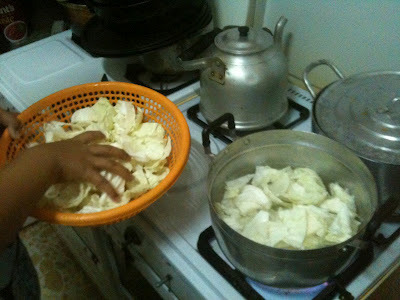
Meanwhile, they’d fry a little vegetable oil in a pan and throw in some very finely chopped garlic and a tiny spoonful of kroeung spice paste, made from pounding gingery galangal, citrusy lemon grass stalks, golden yellow turmeric, and leathery kaffir lime leaves.
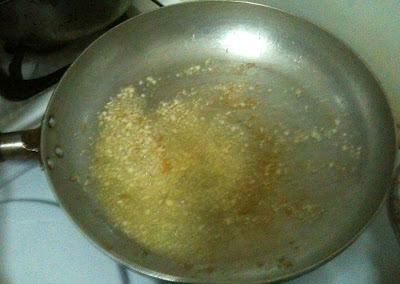
Once the garlic had browned slightly and taken on a splendid, caramelised, nutty taste, they added the drained cabbage and stir-fried it for another minute or so, until it was flecked with the lovely, warm, amber-coloured curry paste. Then they’d make the chilli dipping sauce by pouring fermented fish sauce and sloshing in an equal splash of fresh tap water in a bowl, stirring in some sugar, and adding three or four roughly chopped fiery little chillies.

They served the stir-fried cabbage in a communal bowl and then dug in with chop sticks. It was simple but delicious, and made a small bit of an incredibly crisp, ivory-white, and tremendously robust vegetable go a long way. There was something homely and good, very humble even, about making something out of nothing - a sort of epitome to thrift in these belt-tightening times etc etc.
Oh well. At least I tried Goddamn it. Goodbye.
MORE: What's next for Gordon Ramsay? Monkey Tennis?
:: For more rants about celebrity chefs, my new book Down And Out In Padstow And London about training to be a chef at Heston Blumenthal's Fat Duck, Rick Stein's and other restaurants is available as a paperback and eBook on Amazon CLICK HERE
Published on April 22, 2012 11:22
April 13, 2012
A Umami-Packed Dish That Makes Marmite Taste Like Boiled Lettuce
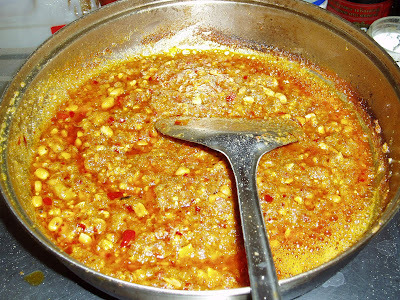
The smell of fermented fish and chillies is wafting from the kitchen. Prahok ling - one of the best meals I’ve come across on my journey to learn about Cambodian food, and a dish so filled with umami it makes Marmite taste like boiled lettuce - is about to be served.
I can’t say I’ve tried every meal the Kingdom has to offer, far from it, but I’ve given it my best shot. I’d always been told how I’d only find the real Cambodian dishes and the secrets of this exotic cuisine in people’s homes, or in street food stalls, and the odd restaurant, and they were right.
I ate incredible dishes like ‘sour soup cooked outside the pot’ where vegetables, bitter herbs, and chopped hard-boiled eggs are formed into balls in each soup bowl and a broth flavoured with dried fish (a stock reminiscent of Japan’s dashi) is poured over the top. A delicious bar snack of steamed ants that tasted of wild honey. A Cambodian bouillabaisse made with hundreds of tiny shrimps and fresh anchovies, and an incredibly fiery dish of chicken livers fried with morning glory.
Then there were the ones best forgotten like stewed pork intestines with pickled cabbage that reminded me of German food for some reason. Boiled duck foetuses scooped from the shell. And that wedding banquet of rat and snake meat that almost coldly furnished forth my funeral the next day.
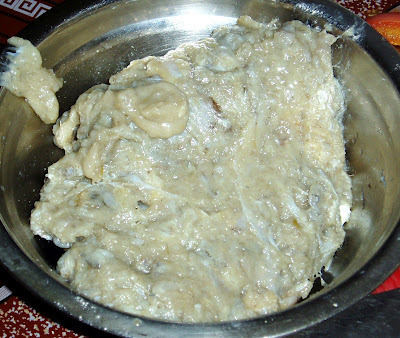
But the dishes I like most are flavoured with prahok (pic above) - a fermented fish paste that is one of the key ingredients of traditional Cambodian cuisine. Cambodian omelette made with fried onions, prahok, and sometimes dried or smoked fish is incredible, as are the chicken, beef and fish soups it’s sometimes used in, or the dips that go with hunks of spit-roast calf, which are sadly no longer a sight on the streets of Cambodia after the government banned them , claiming the sight incited violence and offended Buddhist sensibilities.
If you can’t get hold of prahok, the recipe works pretty well with two tins of anchovies and a tin of sardines (both are rich in umami like prahok, but don’t have the cheesy flavour and notorious odour that comes from its long fermentation process). To make up for this, chop up the fish, put in a bowl, and then stir in one tablespoon of Vietnamese or Thai fish sauce, the whisky-coloured liquor drained from salted and fermented anchovies, prawns or squid. Then add one tablespoon of mashed stilton and one tablespoon of grated parmesan.
It should be an incredibly savoury and salty dish, eaten in small amounts with crudités - cucumber, onion, aubergine, snake beans, and Cambodia’s wonderful white cabbage, with lime quarters to cut the chilli and salt.
The dish is normally made by frying prahok with beaten egg, shallots, chillies, garlic, minced pork, and sometimes tamarind to make a thick dip, which I’ve also seen pressed into a terrine and served in slices. Sometimes pea aubergines are added. But they’re more common in prahok ktis, a similar fried prahok dip made with coconut.
But the version I had the other day was so unusual, containing 20 chillies and a good glug of chilli oil, that I thought I’d share it with you.
Alin, who owns a small restaurant on a near-deserted, white sand paradise that will soon have an ugly five-star resort dropped on top of it, was taught the recipe by her mother before the family moved down from their floating village near Siem Reap .
She was so proud of the prahok she still had from her last visit there, saying it was made from snakehead fish from the Tonle Sap . There she was surrounded by beautiful barracuda, red snapper and some of the best shellfish it’s possible to eat, and all she could think about was the freshwater fish from her childhood. But it’s the same with most Cambodians. They much prefer the taste of freshwater fish, and pay much higher prices for them. And after trying that dish, I don’t blame them.
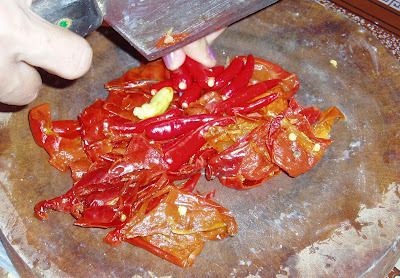
She started by washing the prahok in several changes of water to remove some of the salt. She chopped it for five minutes until it was a grey paste and then put it in a bowl. Next to it were 10 large, dried red chillies she’d soaked for 20 minutes to soften them up. They were there more for the smoky flavour they’d bring to the meal rather than heat. She chopped them up until they were a vibrant red mush. Then she added 10 incendiary bird eye chillies and continued chopping.
“Very spicy,” she said proudly.
She diced four garlic cloves, two red shallots, and poured three tablespoons of vegetable oil into a frying pan. Generally Cambodians just use a smear of oil, and then keep topping up with splashes of water when ‘frying’ food . But this was an emulsified, deeply-rich dip to be eaten sparingly with raw vegetables. As rich as tapenade or brandade de morue, but completely different in taste.
She worked slowly and said little as she chopped. It was wonderful to be in the company of someone so in love with what they’re doing. She tapped away on her board. Then she poured about 50g of peanuts into a pestle and mortar and pounded them for a couple of minutes.

Then she added the garlic to the pan and it quickly became brown and nutty.
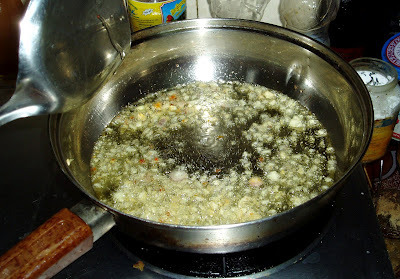
She turned down the heat, added the prahok and the chopped shallots, and stirred again. It soon became a thick, greyish sauce. She added the chopped dry and fresh chillies, stirred again, and added a teaspoon of sugar.
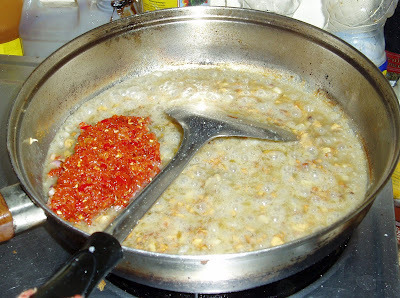
The kitchen was soon filled with chilli fumes. It was so bad, her husband came in with a krama wrapped round his face. Then she added the peanuts and fried them for another two minutes before adding a tablespoon of chilli oil, and two more teaspoons of sugar.

She cooked it for a few more minutes, and then told me to go and sit in the restaurant while she chopped up the crudités.

The Austrian was there. He talked more than any man I’d ever met. His victim this time was a chubby Russian. They were chatting about places they’d been, and I mentioned I was thinking of heading to Sri Lanka.
“Oh, Sri Lanka!” said the Russian. “The food is incredible, absolutely incredible!”
From the size of him, he looked like he knew what he was talking about. He left soon after saying he was off for an hour in the hammock, leaving me with the rabbiting Austrian. Even when my prahok ling arrived he wouldn’t stop. It was too good a meal to waste, so I turned my back to him and kept nodding.
MORE: Fermented Fish And A Tour Of The Market With One Of Cambodia's Top Chefs
:: My new book Down And Out In Padstow And London is available as a paperback and eBook on Amazon CLICK HERE
Published on April 13, 2012 04:49



